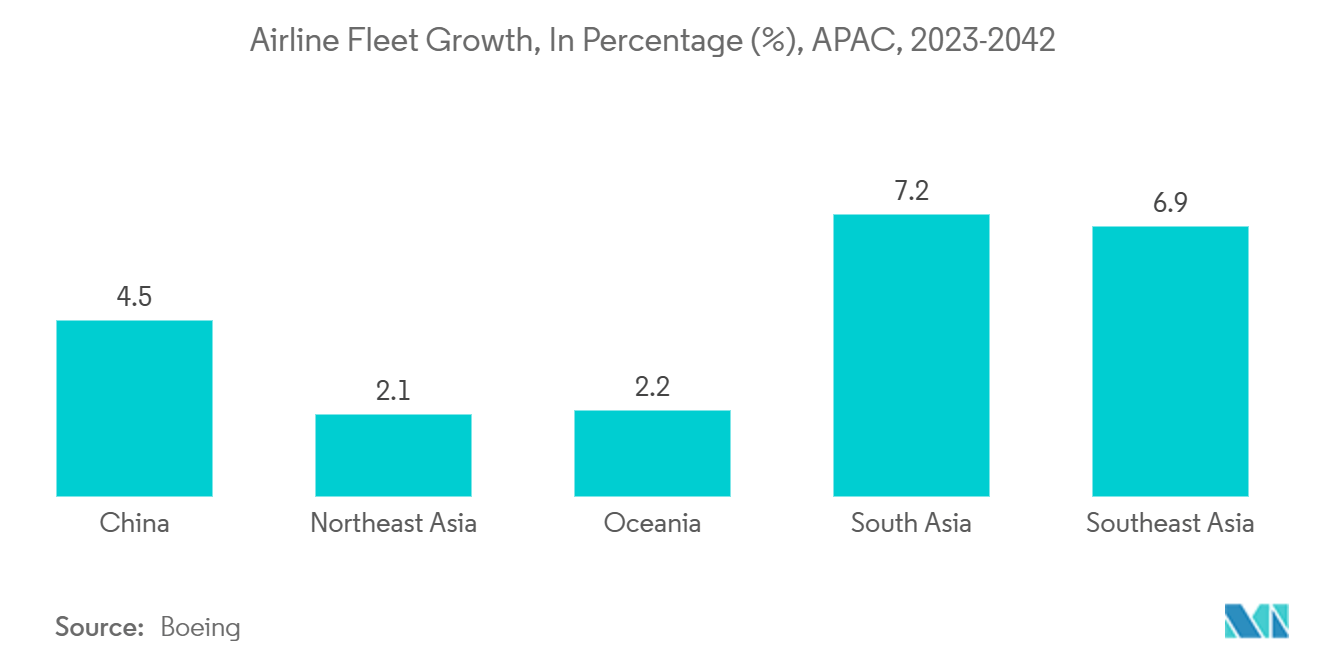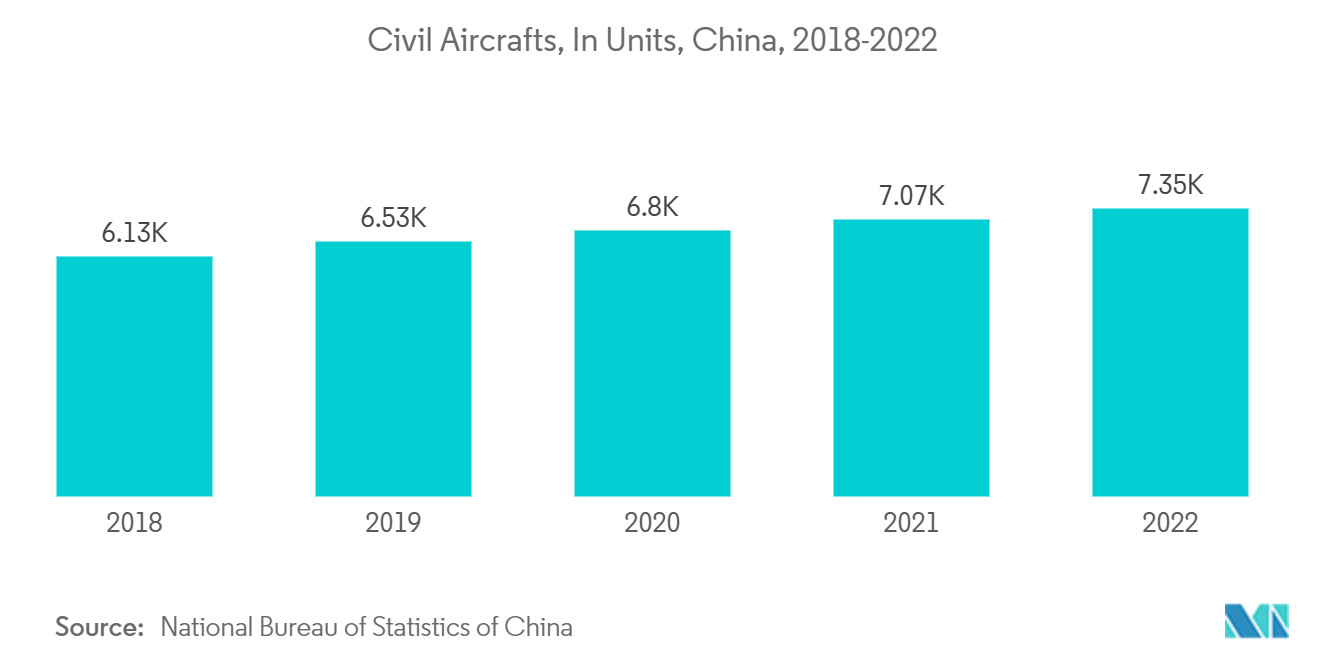Market Trends of Asia Pacific Polyphenylene Sulfide (PPS) Composites Industry
Aerospace and Defense Sector to Drive the Polyphenylene Sulfide (PPS) Composites Market
- The surge in demand for commercial aircraft is having a significant impact on the aerospace and defense industry, driving growth and innovation in several key areas, such as increased demand for material consumption and material innovation and development.
- Polyphenylene sulfide (PPS) composites are widely used in the aerospace and defense industry, as they exhibit a combination of high-temperature performance, creep resistance, excellent dimensional stability, chemical resistance, and flame resistance. Along with other properties, it makes it suitable for interior applications, such as high-temperature ducting, seat frames, and interior panels.
- The manufacturers are focusing on solutions to meet the need to reduce weight and increase fuel efficiency. The materials used in commercial aircraft include aluminum alloys, steel alloys, titanium alloys, and composite materials.
- China's defense industry is increasing, with many Chinese firms displacing Western defense powerhouses. The country invests heavily to upgrade its military, thus making its eight defense firms among the top 25 in the world.
- In June 2021, Indonesia unveiled another plan to spend USD 125 billion through the mid-2040s to upgrade and modernize its military arsenal. The total period runs through a period of five strategic plans, each lasting five years. The first strategic plan runs from 2020 to 2024 and coincides with the final phase of the Minimum Essential Force (MEF) program. The document proposes funding of USD 79 billion for defense equipment during these 25 years, USD 32.5 billion for sustainment, and the remaining USD 13.4 billion for interest payments on foreign loans.
- In Japan, an increase in defense expenditure, rising procurement of next-generation weapons, and adoption of advanced technologies in military communication are driving the growth of the market across Japan. According to the report published by the Stockholm International Peace Research Institute (SIPRI) in 2022, Japan was the tenth largest defense spender in the world, with a defense budget of USD 46 billion. The country approved USD 51.4 billion in defense spending in FY2023.
- In March 2023, Japan Airlines (JAL), Japan's national flag carrier, announced an order of 21 Boeing B737 MAX aircraft. The airline aims to bring advanced and fuel-efficient aircraft into its fleet starting in 2026. The value of the contract was approximately USD 2.5 billion. Haneda International Airport (HND), Narita International Airport (NRT), Kansai International Airport (KIX), and Fukoma International Airport (FUK) are the four major airports in Japan that together handle over 200 million passengers annually. Furthermore, Japanese companies are also actively engaged in providing engineering services towards the development and MRO of aircraft engines, such as the V2500, Trent1000, GEnx, GE9X, PW1100G-JM, etc.
- In March 2022, Singapore disclosed its new procurement plans in pursuit of the SAF 2040 vision. This plan includes several procurements and upgrade programs that the country undertook or will undertake in the coming years. As part of this, the country will also be establishing a fourth service branch for the Singapore Armed Forces (SAF) to defend the country against threats in the digital domain.
- All the factors above are expected to drive the polyphenylene sulfide (PPS) composites market in the region during the forecast period.

China to the Dominate the Asia-Pacific Region
- China is the largest economy in terms of GDP. The IMF (International Monetary Fund) projects a GDP growth of 5% for the country in 2023.
- According to CAAC (Civil Aviation Administration of China), China plans to expand domestic flights and restore international air travel from 2023 to 2025. Given that post-COVID passenger travel is expected to return, the CAAC continues to construct new airports, with an expected total of 270 by 2025.
- The oil and gas industry is one of the key contributors to the Chinese economy. The oil and gas industry operates in high-temperature environments.
- According to BP Statistical Review 2023, the overall oil production in the country reached 204.7 million metric tons in 2022 at a growth rate of 2.9% compared to 198.9 million metric tons produced in 2021.
- Similarly, the country's overall oil consumption is on the rise over the past decade. For instance, in 2022, the country's oil consumption in thousands of barrels per day was 14,295 thousand barrels per day, whereas in 2021, the consumption stood at 14,893 thousand barrels per day. In addition, the consumption growth rate is 3.6% yearly over the decade between 2012 and 22.
- Additionally, China's appetite for aviation seems set to grow exponentially. High demand for aviation led to the government's decision to introduce airport-building programs, which include massive investment in terminals and runways.
- Currently, the annual output of Chinese military aircraft is around 300. As China's military industry continues to grow, the demand for and supply of Chinese military aircraft will increase substantially. It will drive the rapid development of China's military aircraft manufacturing industry.
- Asia is the largest automotive manufacturing hub in the world. The development of electric vehicles is expected to continue to gain momentum in the future, especially in China. Here, many government programs are promoting the move away from fossil fuels, owing to various environmental concerns.
- The Chinese automotive manufacturing industry is the largest in the world. However, the industry witnessed a slowdown in recent years, wherein production and sales declined. According to the China Association of Automobile Manufacturers (CAAM), automotive sales in China fell by 8.4% yoy to 2.56 million units in December 2022, whereas, for the full year 2022, the sales grew to 26.86 million units.
- Furthermore, China holds the world's most extensive production base for electronics. Electronic products, such as smartphones, OLED TVs, tablets, wires, cables, and earphones, are recording the highest growth in electronics.
- All the factors mentioned above are anticipated to propel the polyphenylene sulfide (PPS) composites market in the country during the forecast timeframe.


